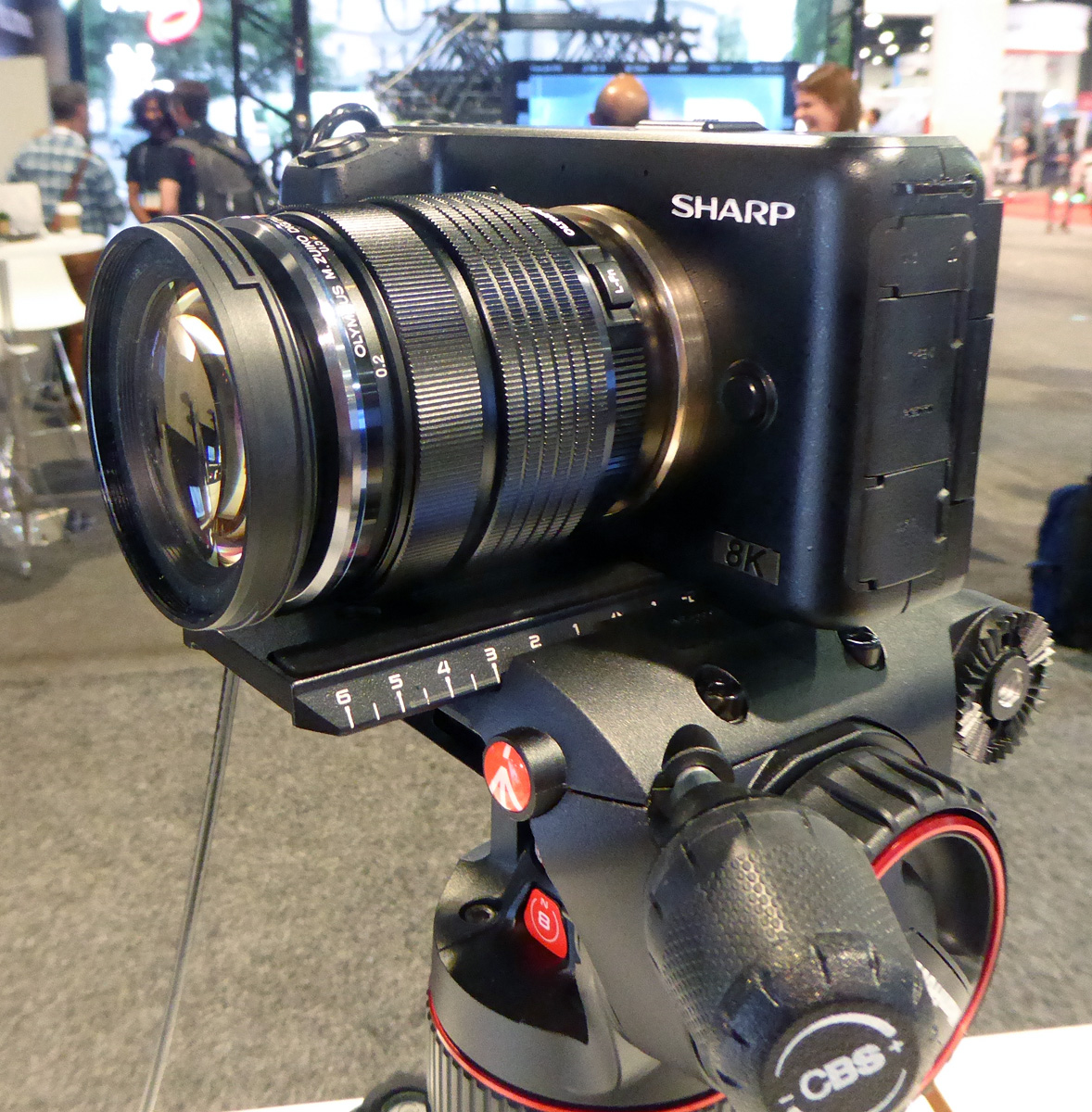Sharp Corporation, best known for bringing LCD televisions, monitors, and projectors to market – and almost going belly-up almost a decade ago – has arisen again and become a major player in the 8K video universe. From the introduction of its first 8K broadcast camera (8C-B60A) in 2017, Sharp has gone all-in with 8K technology.

At the ISE, INC, and NAB shows, the company has shown 8K non-linear editing platforms, 8K storage, 8K streaming, an 8K DLSR with a Micro Four Thirds sensor, and of course, a line of 60”, 70”, and 80” 8K monitors and televisions (which won’t be sold in the U.S. market).
While the 8C-B60A raised quite a few eyebrows, given the company’s financial struggles a decade ago, the push into a complete 8K ecosystem was even more surprising. But then again, more than 60% of Sharp is now owned by Foxconn, which has very deep pockets and which has decided to place a large pile of chips on number “8K” to win. And they’re not just focusing on consumer applications: Sharp also showed laparoscopic cardiac surgery using an 8K “micro” camera and 70-inch monitor at NAB 2019,
 Sharp’s 8K DSLR camera ($4,999 USD), shown at NAB 2019, uses a Micro Four Thirds Bayer sensor and can record 4320p/30 video using interchangeable lenses. Click for higher resolution. Image:P. Putman
Sharp’s 8K DSLR camera ($4,999 USD), shown at NAB 2019, uses a Micro Four Thirds Bayer sensor and can record 4320p/30 video using interchangeable lenses. Click for higher resolution. Image:P. Putman
8K live streaming over WANs was shown at last year’s (2019) CES and NAB shows. Even using 8K cameras to inspect pipes for hairline cracks was demonstrated at this year’s CES.
So, it shouldn’t have been a surprise when the company announced in a press release last week that they had developed a real-time software decoder for video encoded using the next-gen Versatile Video Codec (VVC). VVC, a high-efficiency, high-latency codec, is designed for content distribution over wide area networks (WANs).
The Sharp press release was a little skimpy on details, but here we go:
“The 8K real-time VVC decoder developed by Sharp is the first software in the world able to decode VVC-encoded 8K video in real time. By combining the VVC decoder with video playback software and analytical devices, users will additionally be able to display or analyze 8K content that has been compressed with VVC, even if their equipment does not have existing VVC video decoding capability. Sharp’s proprietary high-speed decoding processes data in real time and realizes smooth playback of video with resolutions up to 8K.”
VVC was developed as a “unified” codec for high dynamic range video, 360-degree virtual reality, and 8K applications by the Joint Video Experts Team, a partnership between the ITU-T Video Compression Experts Group and ISO/IEC Motion Picture Experts Group formed in October 2015. After the rapid adoption of 4K imaging and display technology, this group set out to develop an even more efficient codec than the H.265 High Efficiency Video Codec (HEVC) standard associated with 4K. VVC was the result, and is now registered as ITU-T Recommendation H.266 (ISO/IEC 23090-3).
Like H.265, VVC uses coding tree blocks (CTBs) and transform units (TUs) of variable sizes, depending on inter-frame and intra-frame prediction. While the maximum coding block size in HEVC is 64×64 and the maximum transform size is 32×32, those numbers are doubled for VVC. In theory, if the CPUs in the encoders and decoders are running fast enough, this should make VVC twice as efficient as HEVC, allowing for a reduction in bit rate of 50% with equivalent resolution video. Or, in the case of 8K, enabling streaming at the same rates as 4K using HEVC.
The key is in the software. HEVC and VVC are very software-intensive codecs, requiring fast clock speeds and lots of RAM to perform inter- and intra-frame analysis and determine block sizes and TUs on the fly. Fraunhofer HHS has, at past NAB shows, demonstrated 4K video content streaming at just 15 megabits per second with no visible artifacts, even when encoding confetti blowing around a stage, but they needed two super-fast rack-mount PCs to pull it off. Now, Fraunhofer is engaged in VVC development, showing impressive side-by-side comparisons of HEVC and VVC (40% reduction in bit rate) at CES and NAB in 2019, again using a few rack-mount PCs to handle the heavy lifting.
Sharp’s announcement was all well and good, but like they say in Missouri, “Show me!” Is this new decoder a multi-rack laboratory prototype, or a practical chassis size? What are the signal interfaces? How about GOP sizes and latency? Will Sharp develop this into a commercial product, and if so, how soon? There are just too many unanswered questions right now, but given Sharp’s previous track record with 8K cameras (aided by its partnership with Astro) and access to Foxconn capital, I’m guessing we’ll see it come to market in 2021 and perhaps even demonstrated virtually at CES 2021. – PP

